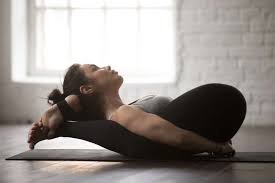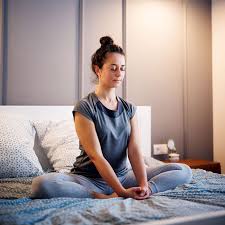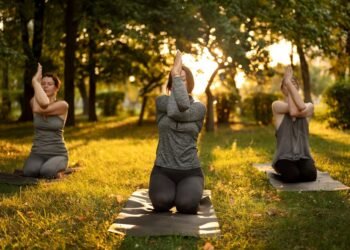Sleep is an essential component of our overall health and well-being, and getting enough restful sleep is crucial for maintaining physical, mental, and emotional health. However, many of us struggle with insomnia, sleep disturbances, or other sleep-related issues that can impact our daily lives. Yoga can be a powerful tool for improving sleep quality and promoting restful sleep. In this article, we’ll explore some yoga poses and techniques that can help to improve sleep quality and promote better sleep.
Child’s Pose (Bal asana)
Child’s pose is a gentle and calming posture that can help to relax the body and prepare for sleep. To practice child’s pose, start on your hands and knees, and then lower your hips back towards your heels. Stretch your arms out in front of you, and rest your forehead on the mat. Take slow, deep breaths, and allow your body to relax and release tension.
Standing Forward Fold (Uttanasana)
Standing forward fold is a calming posture that can help to reduce stress and tension in the body. To practice standing forward fold, stand with your feet hip-width apart, and then fold forward, allowing your head and arms to hang towards the floor. Keep your knees slightly bent, and allow your body to relax and release tension. Take slow, deep breaths, and allow yourself to let go of any worries or concerns.
Legs Up the Wall Pose (Viperidae Kirani)
Legs up the wall pose is a restorative posture that can help to reduce stress and tension in the body, and promote relaxation and restful sleep. To practice legs up the wall pose, lie on your back with your hips close to a wall, and then lift your legs up and rest them against the wall. Allow your arms to rest by your sides, and take slow, deep breaths. Stay in the posture for several minutes, allowing your body to relax and release tension.

Reclining Bound Angle Pose (Sputa Buddha Koyasan)
Reclining bound angle pose is a restorative posture that can help to reduce stress and tension in the body, and promote relaxation and restful sleep. To practice reclining bound angle pose, lie on your back with your knees bent and the soles of your feet together. Allow your knees to fall open towards the floor, and rest your arms by your sides. Take slow, deep breaths, and allow your body to relax and release tension.
Alternate Nostril Breathing (Nadi Shodhana Pranayama)
Alternate nostril breathing is a yogic breathing technique that can help to calm the mind and promote relaxation. To practice alternate nostril breathing, sit comfortably and place your left hand on your left knee. Use your right hand to close your right nostril, and inhale deeply through your left nostril. Then, close your left nostril with your right ring finger, and exhale through your right nostril. Inhale through your right nostril, and then close it with your right thumb. Exhale through your left nostril. Continue alternating inhaling and exhaling through each nostril, and allow yourself to relax and release tension.
Progressive Muscle Relaxation
Progressive muscle relaxation is a relaxation technique that involves tensing and then relaxing different muscle groups in the body. To practice progressive muscle relaxation, lie on your back and take slow, deep breaths. Then, tense the muscles in your feet and hold for a few seconds, before releasing and relaxing. Continue tensing and relaxing different muscle groups, moving up the body from your feet to your head. Allow yourself to sink deeper into relaxation with each muscle group.
Practicing yoga can be a powerful tool for improving sleep quality and promoting restful sleep. By incorporating calming postures such as child’s pose, standing forward fold, legs up the wall pose, and reclining bound angle pose, and practicing relaxation techniques such as alternate nostril breathing and progressive muscle relaxation, you can create a soothing and restful environment that promotes relaxation and restful sleep. So, take the time to explore these yoga techniques, and discover the transformative power of yoga for better sleep.

It’s important to remember that creating a consistent yoga practice can take time and patience, and that it may take some experimentation to find the postures and techniques that work best for you. It’s also important to remember that yoga is a holistic practice that involves not only physical postures, but also breath work, meditation, and other techniques that can help to promote relaxation and restful sleep.
In addition to practicing yoga, there are other lifestyle factors that can impact sleep quality and duration. It’s important to maintain a regular sleep schedule, avoid caffeine and alcohol before bedtime, and create a calming bedtime routine that promotes relaxation and restful sleep.
It’s also important to seek medical attention if you experience chronic or severe sleep issues, as sleep disturbances can be a sign of underlying health conditions that require medical attention.
Furthermore, practicing yoga for better sleep can also have a positive impact on other areas of your life. Improved sleep quality can lead to increased energy, better mood, and improved cognitive function, which can all contribute to a happier, healthier, and more fulfilling life.
In addition, practicing yoga can also help to reduce stress and anxiety, which are common factors that can contribute to sleep issues. By cultivating mindfulness and present-moment awareness through yoga, you can learn to manage stress and anxiety more effectively, and create a sense of balance and well-being in your life.
Finally, it’s important to remember that yoga is a personal practice, and that it can be adapted to meet your unique needs and abilities. If you have physical limitations or injuries, it’s important to modify the postures or seek the guidance of a qualified yoga teacher. If you have any medical concerns or limitations, it’s important to consult with a healthcare provider before beginning a yoga practice.
In conclusion,
practicing yoga for better sleep can be a powerful way to improve sleep quality, reduce stress and anxiety, and promote overall health and well-being. By incorporating calming postures and relaxation techniques into your daily routine, and making healthy lifestyle choices that support sleep, you can create a soothing and restful environment that promotes better sleep and improved health. So, take the time to explore these yoga techniques and lifestyle factors, and discover the transformative power of yoga for better sleep




